Drought Monitoring in the Agrotechnological Districts of the Semear Digital Center
Abstract
:1. Introduction
2. Materials and Methods
2.1. Study Area
Climate and Elevation
2.2. Validation and SPEI Calculation
2.3. Analysis of Trends: Comparing 2000–2012 and 2013–2024
2.4. SPEI Intensity and Frequency: Comparing 2000–2012 and 2013–2024
3. Results
3.1. Validation of Climate Data Derived from Remote Sensing
3.2. Precipitation and Temperature Anomaly
3.3. Trend of SPEI-6
3.4. Frequency of Droughts by Intensity Category
3.4.1. Slight Drought
3.4.2. Moderate Drought
3.4.3. Severe Drought
3.4.4. Extreme Drought
3.4.5. Exceptional Drought
4. Discussion
5. Conclusions
Supplementary Materials
Author Contributions
Funding
Institutional Review Board Statement
Informed Consent Statement
Data Availability Statement
Acknowledgments
Conflicts of Interest
References
- Semear Digital. Available online: https://www.semear-digital.cnptia.embrapa.br/dats/ (accessed on 11 January 2025).
- Massruhá, S.M.F.S.; Leite, M.A.D.A.; Oliveira, S.R.D.M.; Meira, C.A.A.; Luchiari Junior, A.; Bolfe, E.L. (Eds.) Digital Agriculture: Research, Development and Innovation in Production Chains; Embrapa: Brasília, Brazil, 2023; Chapter 1; pp. 17–35. [Google Scholar]
- Pivot, D.; Waquil, P.D.; Talamini, E.; Finocchio, C.P.S.; Dalla Corte, V.F.; de Vargas Mores, G. Scientific development of smart farming technologies and their application in Brazil. Inf. Process. Agric. 2018, 5, 21–32. [Google Scholar] [CrossRef]
- Moysiadis, V.; Sarigiannidis, P.; Vitsas, V.; Khelifi, A. Smart farming in Europe. Comput. Sci. Rev. 2021, 39, 100345. [Google Scholar] [CrossRef]
- Idoje, G.; Dagiuklas, T.; Iqbal, M. Survey for smart farming technologies: Challenges and issues. Comput. Electr. Eng. 2021, 92, 107104. [Google Scholar] [CrossRef]
- Shamshiri, R.R.; Sturm, B.; Weltzien, C.; Fulton, J.; Khosla, R.; Schirrmann, M.; Raut, S.; Basavegowda, D.H.; Yamin, M.; Hameed, I.A. Digitalization of Agriculture for sustainable crop production: A use-case review. Front. Environ. Sci. 2024, 12, 1375193. [Google Scholar] [CrossRef]
- Fuentes-Peñailillo, F.; Gutter, K.; Vega, R.; Silva, G.C. Transformative Technologies in Digital Agriculture: Leveraging Internet of Things, Remote Sensing, and Artificial Intelligence for Smart Crop Management. J. Sens. Actuator Netw. 2024, 13, 39. [Google Scholar] [CrossRef]
- Assunção, J.; Chein, F. Climate change and agricultural productivity in Brazil: Future perspectives. Environ. Dev. Econ. 2016, 21, 581–602. [Google Scholar] [CrossRef]
- IPCC. Summary for Policymakers. In Climate Change 2023: Synthesis Report. Contribution of Working Groups I, II and III to the Sixth Assessment Report of the Intergovernmental Panel on Climate Change; Core Writing Team, Lee, H., Romero, J., Eds.; IPCC: Geneva, Switzerland, 2023; pp. 1–34. Available online: https://www.ipcc.ch/report/ar6/syr/downloads/report/IPCC_AR6_SYR_FullVolume.pdf (accessed on 4 April 2025).
- Cunha, A.P.M.A.; Zeri, M.; Deusdará Leal, K.; Costa, L.; Cuartas, L.A.; Marengo, J.A.; Tomasella, J.; Vieira, R.M.; Barbosa, A.A.; Cunningham, C.; et al. Extreme Drought Events over Brazil from 2011 to 2019. Atmosphere 2019, 10, 642. [Google Scholar] [CrossRef]
- Geirinhas, J.L.; Russo, A.; Libonati, R.; Sousa, P.M.; Miralles, D.G.; Trigo, R.M. Recent increasing frequency of compound summer drought and heatwaves in Southeast Brazil. Environ. Res. Lett. 2021, 16, 034036. [Google Scholar] [CrossRef]
- Wilhite, D.A.; Glantz, M.H. Understanding: The drought phenomenon: The role of definitions. Water Int. 1985, 10, 111–120. [Google Scholar] [CrossRef]
- Hazaymeh, K.; Hassan, Q.K. Remote sensing of agricultural drought monitoring: A state of art review. AIMS Environ. Sci. 2016, 3, 604–630. [Google Scholar] [CrossRef]
- Marengo, J.A.; Galdos, M.V.; Challinor, A.; Cunha, A.P.; Marin, F.R.; Vianna, M.d.S.; Alvala, R.C.S.; Alves, L.M.; Moraes, O.L.; Bender, F. Drought in Northeast Brazil: A review of agricultural and policy adaptation options for food security. Clim. Resil Sustain. 2021, 1, e17. [Google Scholar] [CrossRef]
- van Ginkel, M.; Biradar, C. Drought Early Warning in Agri-Food Systems. Climate 2021, 9, 134. [Google Scholar] [CrossRef]
- Sass, K.S.; Konak, A.; de Macedo, M.B.; Benso, M.R.; Shrimpton, E.; Balta-Ozkan, N.; Sarmah, T.; Mendiondo, E.M.; da Silva, G.J.; da Silva, P.G.C.; et al. Enhancing drought resilience and vulnerability assessment in small farms: A global expert survey on multidimensional indicators. Int. J. Disaster Risk Reduct. 2024, 110, 104616. [Google Scholar] [CrossRef]
- Palmer, W.C. Meteorological Drought; Research Paper No. 45; U.S. Department of Commerce, Weather Bureau: Washington, DC, USA, 1965; pp. 1–58.
- Palmer, W.C. Keeping track of crop moisture conditions, nationwide: The New Crop Moisture Index. Weatherwise 1968, 21, 156–161. [Google Scholar] [CrossRef]
- McKee, T.B.; Doesken, N.J.; Kleist, J. The relationship of drought frequency and duration to time scales. In Proceedings of the Eight Conference on Applied Climatology, Anaheim, CA, USA, 17–22 January 1993; American Meteorological Society: Boston, MA, USA, 1993; pp. 179–184. [Google Scholar]
- Vicente-Serrano, S.M.; Beguería, S.; López-Moreno, J.I. A Multiscalar Drought Index Sensitive to Global Warming: The Standardized Precipitation Evapotranspiration Index. J. Clim. 2010, 23, 1696–1718. [Google Scholar] [CrossRef]
- Kogan, F.N. Application of vegetation index and brightness temperature for drought detection. Adv. Space Res. 1995, 15, 91–100. [Google Scholar] [CrossRef]
- Gao, B. NDWI—A normalized difference water index for remote sensing of vegetation liquid water from space. Remote Sens. Environ. 1996, 58, 257–266. [Google Scholar] [CrossRef]
- Kogan, F.N. Global drought watch from space. Bull. Am. Meteorol. Soc. 1997, 78, 621–636. [Google Scholar] [CrossRef]
- Sandholt, I.; Rasmussen, K.; Andersen, J. A simple interpretation of the surface temperature/vegetation index space for assessment of surface moisture status. Remote Sens. Environ. 2002, 79, 213–224. [Google Scholar] [CrossRef]
- Liu, X.; Zhu, X.; Pan, Y.; Li, S.; Liu, Y.; Ma, Y. Agricultural drought monitoring: Progress, challenges, and prospects. J. Geogr. Sci. 2016, 26, 750–767. [Google Scholar] [CrossRef]
- Ndayiragije, J.M.; Li, F. Effectiveness of Drought Indices in the Assessment of Different Types of Droughts, Managing and Mitigating Their Effects. Climate 2022, 10, 125. [Google Scholar] [CrossRef]
- Nikolova, N.; Radeva, K.; Todorov, L.; Matev, S. Drought Dynamics and Drought Hazard Assessment in Southwest Bulgaria. Atmosphere 2024, 15, 888. [Google Scholar] [CrossRef]
- Drumond, A.; de Oliveira, M.; Reboita, M.S.; Stojanovic, M.; Nunes, A.M.P.; da Rocha, R.P. Moisture Transport during Anomalous Climate Events in the La Plata Basin. Atmosphere 2024, 15, 876. [Google Scholar] [CrossRef]
- Yang, W.; Doulabian, S.; Shadmehri Toosi, A.; Alaghmand, S. Unravelling the Drought Variance Using Machine Learning Methods in Six Capital Cities of Australia. Atmosphere 2024, 15, 43. [Google Scholar] [CrossRef]
- Peng, Y.; Peng, T.; Li, Y. Spatiotemporal Characteristics of Drought in Northwest China Based on SPEI Analysis. Atmosphere 2023, 14, 1188. [Google Scholar] [CrossRef]
- Pacheco, J.; Solera, A.; Avilés, A.; Tonón, M.D. Influence of ENSO on Droughts and Vegetation in a High Mountain Equatorial Climate Basin. Atmosphere 2022, 13, 2123. [Google Scholar] [CrossRef]
- Espinosa, L.A.; Portela, M.M.; Matos, J.P.; Gharbia, S. Climate Change Trends in a European Coastal Metropolitan Area: Rainfall, Temperature, and Extreme Events (1864–2021). Atmosphere 2022, 13, 1995. [Google Scholar] [CrossRef]
- Thornthwaite, C.W. An Approach toward a Rational Classification of Climate. Geogr. Rev. 1948, 38, 55–94. [Google Scholar] [CrossRef]
- World Meteorological Organization. Standardized Precipitation Index User Guide; WMO-No. 1090; WMO: Geneva, Switzerland, 2012; pp. 1–16. [Google Scholar]
- Buma, W.G.; Lee, S.-I. Multispectral Image-Based Estimation of Drought Patterns and Intensity around Lake Chad, Africa. Remote Sens. 2019, 11, 2534. [Google Scholar] [CrossRef]
- Cuartas, L.A.; Cunha, A.P.M.d.A.; Alves, J.A.; Parra, L.M.P.; Deusdará-Leal, K.; Costa, L.C.O.; Molina, R.D.; Amore, D.; Broedel, E.; Seluchi, M.E.; et al. Recent Hydrological Droughts in Brazil and their Impact on Hydropower Generation. Water 2022, 14, 601. [Google Scholar] [CrossRef]
- Ryu, J.-H.; Han, K.-S.; Lee, Y.-W.; Park, N.-W.; Hong, S.; Chung, C.-Y.; Cho, J. Different Agricultural Responses to Extreme Drought Events in Neighboring Counties of South and North Korea. Remote Sens. 2019, 11, 1773. [Google Scholar] [CrossRef]
- Tomasella, J.; Cunha, A.P.M.A.; Simões, P.A.; Zeri, M. Assessment of trends, variability and impacts of droughts across Brazil over the period 1980–2019. Nat. Hazards 2022, 116, 2173–2190. [Google Scholar] [CrossRef]
- Funk, C.; Peterson, P.; Landsfeld, M.; Pedreros, D.; Verdin, J.; Shukla, S.; Husak, G.; Rowland, J.; Harrison, L.; Hoell, A.; et al. The climate hazards infrared precipitation with stations—A new environmental record for monitoring extremes. Sci. Data 2015, 2, 150066. [Google Scholar] [CrossRef] [PubMed]
- MODIS. MOD11A1 v061: MODIS/Terra Land Surface Temperature/Emissivity Daily L3 Global 1km SIN Grid; NASA LP DAAC: Sioux Falls, SD, USA, 2021. [CrossRef]
- Agritempo. Available online: https://www.agritempo.gov.br/br/sobre-nos/ (accessed on 10 December 2024).
- Alvares, C.A.; Stape, J.L.; Sentelhas, P.C.; de Moraes, G.J.L.; Sparovek, G. Köppen’s Climate Classification Map for Brazil. Meteorol. Z. 2013, 22, 711–728. [Google Scholar] [CrossRef] [PubMed]
- European Union, Copernicus Land Monitoring Service. Copernicus Digital Elevation Model GLO-30. 2024. Available online: https://dataspace.copernicus.eu/ (accessed on 12 December 2024).
- Pearson, K., VII. Mathematical contributions to the theory of evolution.—III. Regression, heredity, and panmixia. Philos. Trans. R. Soc. London. Ser. A Contain. Pap. A Math. Or. Phys. Character 1896, 187, 253–318. [Google Scholar] [CrossRef]
- Willmott, C.J. Some Comments on the Evaluation of Model Performance. Bull. Amer. Meteor. Soc. 1982, 63, 1309–1313. [Google Scholar] [CrossRef]
- Schober, P.; Boer, C.; Schwarte, L.A. Correlation Coefficients: Appropriate use and interpretation. Anesth. Analg. 2018, 126, 1763–1768. [Google Scholar] [CrossRef]
- Beguería, S.; Vicente-Serrano, S.M. SPEI: Calculation of the Standardized Precipitation-Evapotranspiration Index (Version 1.7) [Computer Software]. 2017. Available online: https://CRAN.R-project.org/package=SPEI (accessed on 11 January 2025).
- Hamed, K.H.; Rao, A.R. A modified Mann-Kendall trend test for autocorrelated data. J. Hydrol. 1998, 204, 182–196. [Google Scholar] [CrossRef]
- Hussain, M.M.; Mahmud, I. PyMannKendall: A python package for non parametric mann kendall family of trend tests. J. Open Source Softw. 2019, 4, 1556. [Google Scholar] [CrossRef]
- Monitor de Secas do Brasil. Available online: https://monitordesecas.ana.gov.br/tabela-de-classificacao (accessed on 10 December 2024).
- Liu, J.; Hagan, D.F.T.; Holmes, T.R.; Liu, Y. An Analysis of Spatio-Temporal Relationship between Satellite-Based Land Surface Temperature and Station-Based Near-Surface Air Temperature over Brazil. Remote Sens. 2022, 14, 4420. [Google Scholar] [CrossRef]
- Wan, Z.; Zhang, Y.; Zhang, Q.; Li, Z.L. Quality assessment and validation of the MODIS global land surface temperature. Int. J. Remote Sens. 2004, 25, 261–274. [Google Scholar] [CrossRef]
- Wan, Z.; Zhang, Y.; Zhang, Q.; Li, Z. Validation of the land-surface temperature products retrieved from Terra Moderate Resolution Imaging Spectroradiometer data. Remote Sens. Environ. 2002, 83, 163–180. [Google Scholar] [CrossRef]
- World Meteorological Organization. Chapter 2: Measurement of Temperature. In Guide to Instruments and Methods of Observation: Volume I–Measurement of Meteorological Variables (WMO-No. 8); WMO: Geneva, Switzerland, 2012; pp. 90–124. [Google Scholar]
- Mildrexler, D.J.; Zhao, M.; Running, S.W. A global comparison between station air temperatures and MODIS land surface temperatures reveals the cooling role of forests. J. Geophys. Res. 2011, 116, G03025. [Google Scholar] [CrossRef]
- Golkar, F.; Sabziparvar, A.A.; Khanbilvardi, R.; Nazemosadat, M.J.; Zand-Parsa, S.; Rezaei, Y. Estimation of instantaneous air temperature using remote sensing data. Int. J. Remote Sens. 2017, 39, 258–275. [Google Scholar] [CrossRef]
- Mutiibwa, D.; Strachan, S.; Albright, T. Land Surface Temperature and Surface Air Temperature in Complex Terrain. IEEE J. Sel. Top. Appl. Earth Obs. Remote Sens. 2015, 8, 4762–4774. [Google Scholar] [CrossRef]
- Urban, M.; Eberle, J.; Hüttich, C.; Schmullius, C.; Herold, M. Comparison of Satellite-Derived Land Surface Temperature and Air Temperature from Meteorological Stations on the Pan-Arctic Scale. Remote Sens. 2013, 5, 2348–2367. [Google Scholar] [CrossRef]
- El Kenawy, A.M.; Hereher, M.E.; Robaa, S.M. An Assessment of the Accuracy of MODIS Land Surface Temperature over Egypt Using Ground-Based Measurements. Remote Sens. 2019, 11, 2369. [Google Scholar] [CrossRef]
- World Meteorological Organization (WMO); United Nations Educational, Scientific and Cultural Organization (UNESCO); United Nations Environment Programme (UNEP); International Council for Science (ICSU). Systematic Observation Requirements for Satellite-Based Products for Climate Supplemental Details to the Satellite-Based Component of the Implementation Plan for the Global Observing System for Climate in Support of the UNFCCC; WMO: Geneva, Switzerland, 2011; Available online: https://library.wmo.int/idurl/4/48411 (accessed on 11 January 2025).
- Ummus, M.E. Avaliações de Estimativas de Temperatura da Superfície Terrestre em Eventos Frios Para a Regiao Sul do Brasil, Utilizando dados do Sensor MODIS; INPE: São Jose dos Campos, Brazil, 2009; p. 129. Available online: http://urlib.net/sid.inpe.br/mtc-m18@80/2009/08.31.21.00 (accessed on 11 January 2025).
- Oliveira-Júnior, J.F.d.; Silva Junior, C.A.d.; Teodoro, P.E.; Rossi, F.S.; Blanco, C.J.C.; Lima, M.; Gois, G.d.; Correia Filho, W.L.F.; Santiago, D.d.B.; Vanderley, M.H.G.d.S. Confronting CHIRPS dataset and in situ stations in the detection of wet and drought conditions in the Brazilian Midwest. Int. J. Climatol. 2021, 41, 4478–4493. [Google Scholar] [CrossRef]
- Caparoci Nogueira, S.; Moreira, M.; Lordelo Volpato, M. Evaluating Precipitation Estimates from Eta, TRMM and CHRIPS Data in the South-Southeast Region of Minas Gerais State—Brazil. Remote Sens. 2018, 10, 313. [Google Scholar] [CrossRef]
- Paredes-Trejo, F.J.; Barbosa, H.A.; Lakshmi Kumar, T.V. Validating CHIRPS-Based Satellite Precipitation Estimates in Northeast Brazil. J. Arid Environ. 2017, 139, 26–40. [Google Scholar] [CrossRef]
- Cavalcante, R.B.; Ferreira, D.B.d.S.; Pontes, P.R.M.; Tedeschi, R.G.; Costa, C.P.W.d.; Souza, E.B.d. Evaluation of extreme rainfall indices from CHIRPS precipitation estimates over the Brazilian Amazonia. Atmos. Res. 2020, 238, 104879. [Google Scholar] [CrossRef]
- Du, H.; Tan, M.L.; Zhang, F.; Chun, K.P.; Li, L.; Kabir, M.H. Evaluating the effectiveness of CHIRPS data for hydroclimatic studies. Theor. Appl. Climatol. 2023, 155, 1519–1539. [Google Scholar] [CrossRef]
- Wu, W.; Li, Y.; Luo, X.; Zhang, Y.; Ji, X.; Li, X. Performance evaluation of the CHIRPS precipitation dataset and its utility in drought monitoring over Yunnan Province, China. Geomat. Nat. Hazards Risk 2019, 10, 2145–2162. [Google Scholar] [CrossRef]
- dos Santos, L.O.F.; Machado, N.G.; Biudes, M.S.; Geli, H.M.E.; Querino, C.A.S.; Ruhoff, A.L.; Ivo, I.O.; Lotufo Neto, N. Trends in Precipitation and Air Temperature Extremes and Their Relationship with Sea Surface Temperature in the Brazilian Midwest. Atmosphere 2023, 14, 426. [Google Scholar] [CrossRef]
- Martini, L.C.P. Changes in rainfall patterns in southern Brazil over 1961–2020 period detected by rain gauge data. Int. J. Climatol. 2022, 42, 9101–9114. [Google Scholar] [CrossRef]
- Luiz-Silva, W.; Oscar-Júnior, A.C.; Cavalcanti, I.F.A.; Treistman, F. An overview of precipitation climatology in Brazil: Space-time variability of frequency and intensity associated with atmospheric systems. Hydrol. Sci. J. 2021, 66, 289–308. [Google Scholar] [CrossRef]
- Curado, L.F.A.; de Paulo, S.R.; de Paulo, I.J.C.; de Oliveira Maionchi, D.; da Silva, H.J.A.; de Oliveira Costa, R.; da Silva, I.M.C.B.; Marques, J.B.; de Souza Lima, A.M.; Rodrigues, T.R. Trends and Patterns of Daily Maximum, Minimum and Mean Temperature in Brazil from 2000 to 2020. Climate 2023, 11, 168. [Google Scholar] [CrossRef]
- Marengo, J.A.; Jimenez, J.C.; Espinoza, J.C.; Cunha, A.P.; Aragão, L.E.O. Increased climate pressure on the agricultural frontier in the Eastern Amazonia–Cerrado transition zone. Sci. Rep. 2022, 12, 457. [Google Scholar] [CrossRef]
- CEMADEN; INPE. Nota Técnica: Elaboração dos Mapas de Índice de Aridez e Precipitação Total Acumulada para o Brasil. Centro Nacional de Monitoramento e Alertas de Desastres Naturais (CEMADEN), Instituto Nacional de Pesquisas Espaciais (INPE), 2023. Available online: https://www.gov.br/cemaden/pt-br/assuntos/noticias-cemaden/estudo-do-cemaden-e-do-inpe-identifica-pela-primeira-vez-a-ocorrencia-de-uma-regiao-arida-no-pais/nota-tecnica_aridas.pdf (accessed on 3 February 2025).
- Stríkis, N.M.; Buarque, P.F.S.M.; Cruz, F.W.; Bernal, J.P.; Vuille, M.; Tejedor, E.; Santos, M.S.; Shimizu, M.H.; Ampuero, A.; Du, W.; et al. Modern anthropogenic drought in Central Brazil unprecedented during last 700 years. Nat. Commun. 2024, 15, 1728. [Google Scholar] [CrossRef]
- G1. Available online: https://g1.globo.com/sp/sao-carlos-regiao/noticia/2020/10/09/falta-de-chuva-e-baixa-umidade-do-ar-devem-causar-prejuizo-a-safra-do-cafe-em-caconde.ghtml (accessed on 10 December 2024).
- AP News. Available online: https://apnews.com/article/brazil-climate-change-drought-coffee-harvest-a6516a4b314e6ba7c11513c08afb6996 (accessed on 10 December 2024).
- DaMatta, F.M.; Ramalho, J.D.C. Impacts of drought and temperature stress on coffee physiology and production: A review. Braz. J. Plant Physiol. 2006, 18, 55–81. [Google Scholar] [CrossRef]
- Moraes-Oliveira, A.F.d.; Aparecido, L.E.d.O.; Figueira, S.R.F. Economic and climatic models for estimating coffee supply. Pesqui. Agropecuária Bras. 2017, 52, 1158–1166. [Google Scholar] [CrossRef]
- Semear Digital. Available online: https://www.semear-digital.cnptia.embrapa.br/noticia/01/2025/parceria-vai-levar-conectividade-e-tecnologia-digital-para-manejo-de-pragas-em-pequenas-e-medias-propriedades/ (accessed on 3 February 2025).
- Semear Digital. Available online: https://www.semear-digital.cnptia.embrapa.br/noticia/10/2024/comite-internacional-do-projeto-semear-digital-visita-embrapa-e-instituicoes-parceiras-2/ (accessed on 3 February 2025).
- Agrofy News. Available online: https://news.agrofy.com.br/noticia/204060/embrapa-vai-levar-inclusao-digital-fruticultores-do-rs (accessed on 3 February 2025).
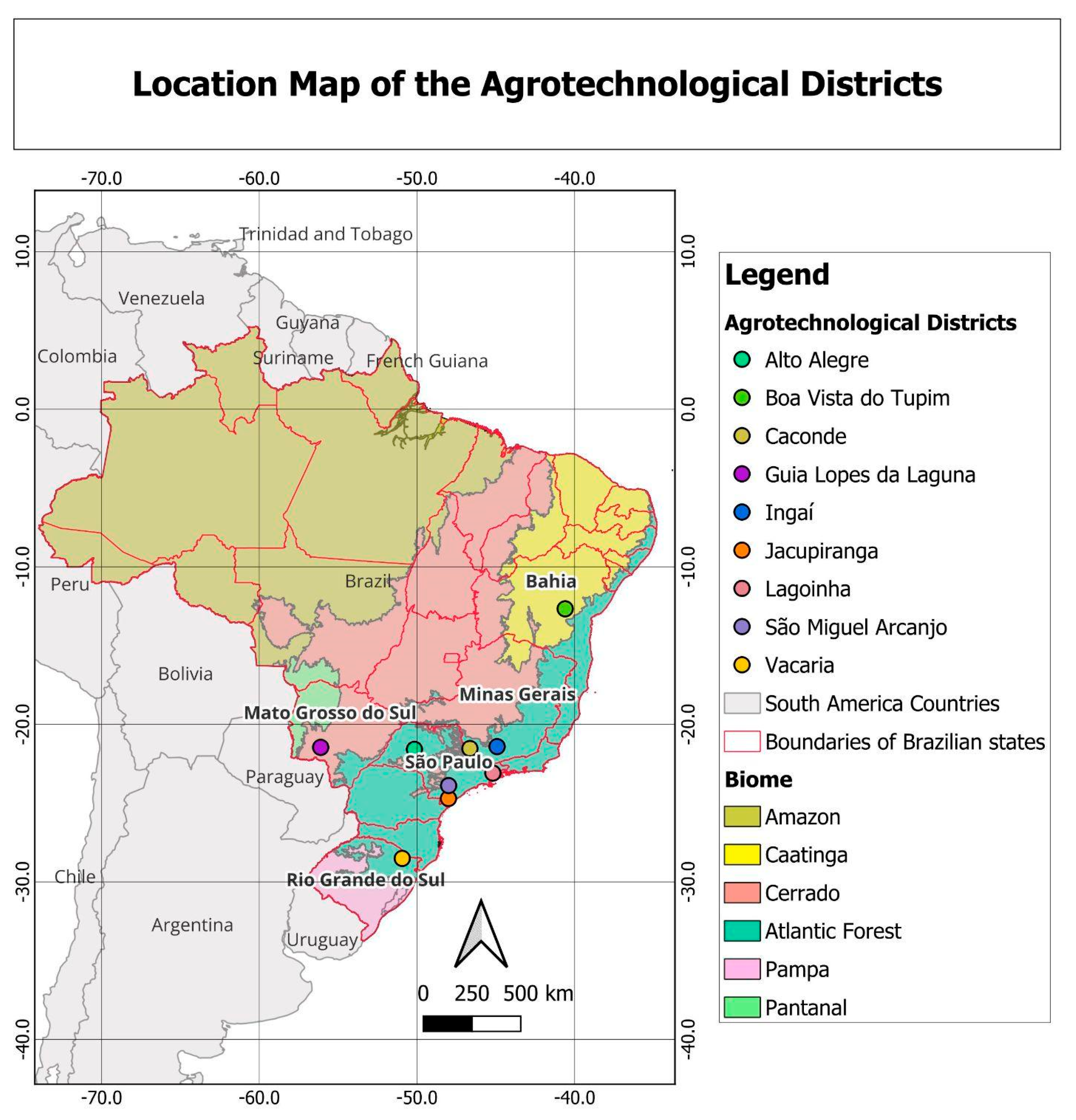
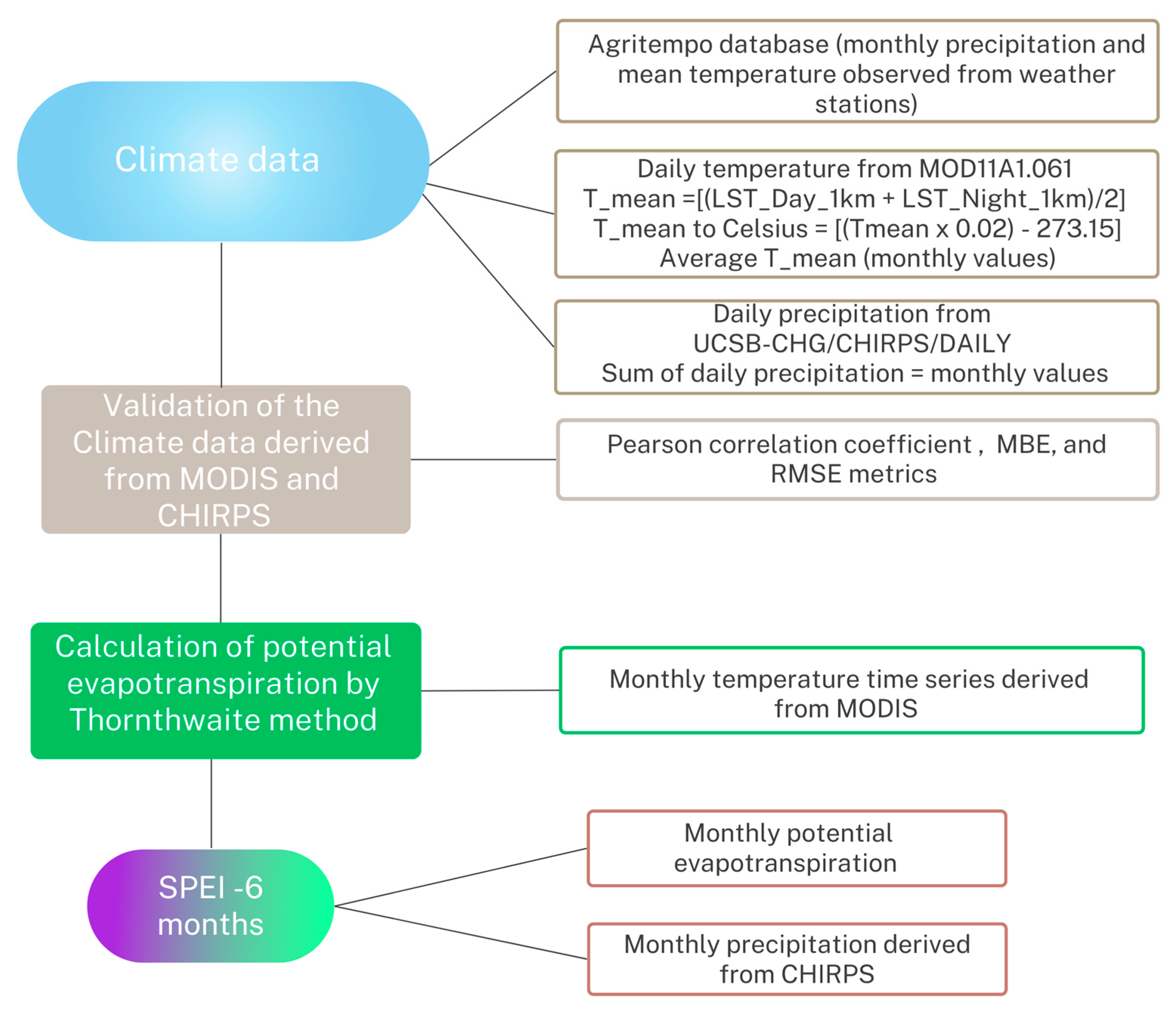
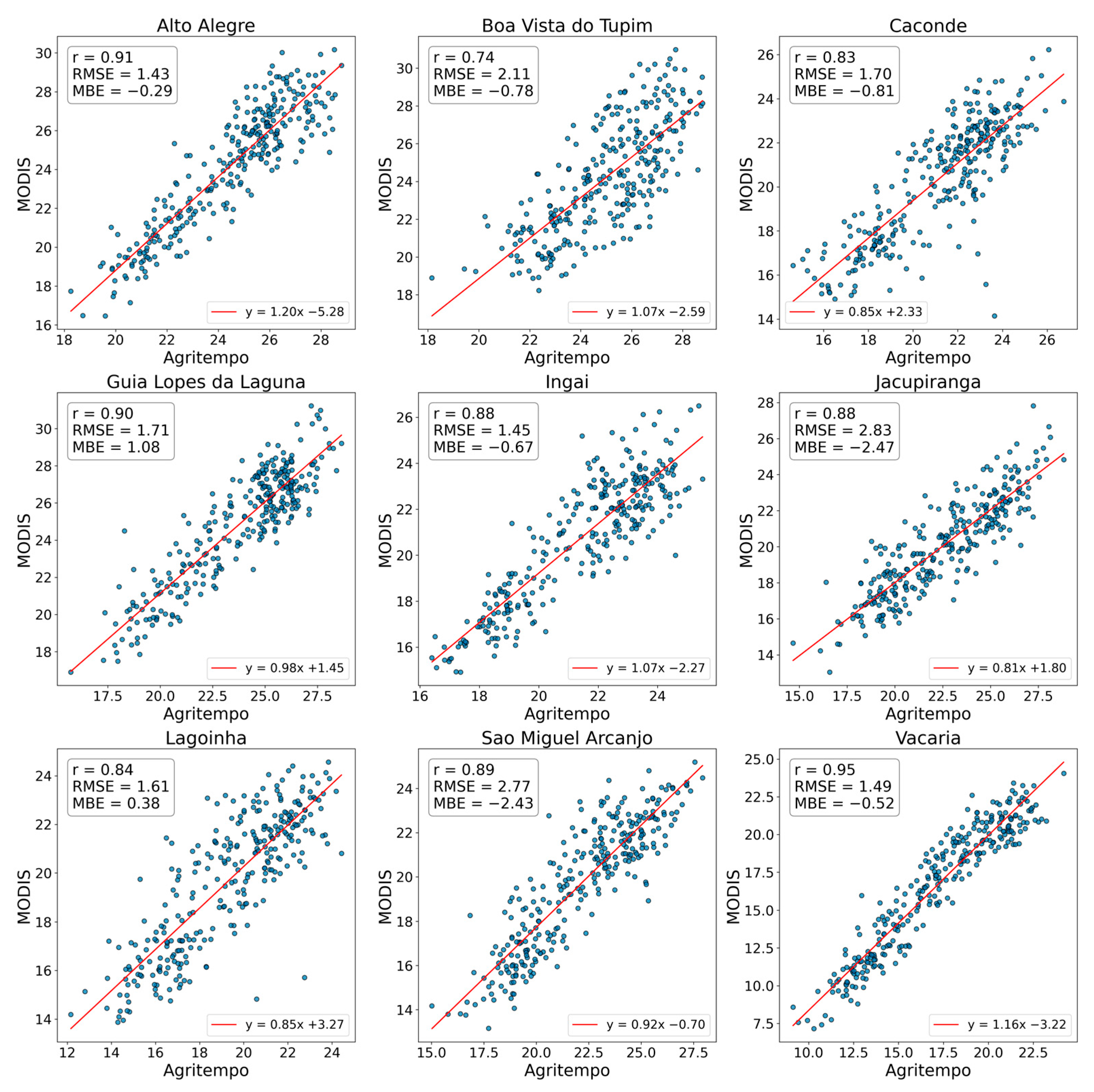
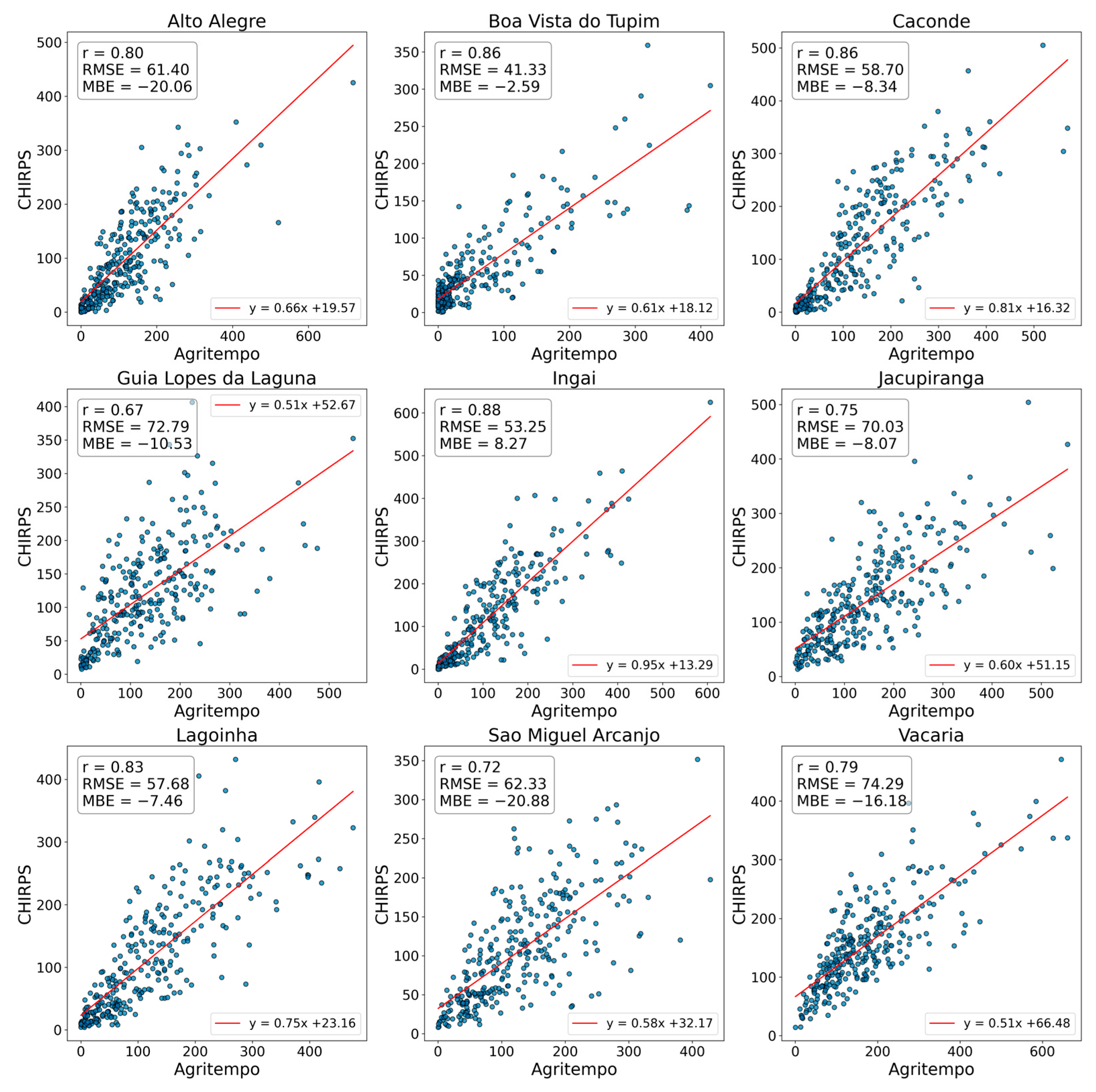
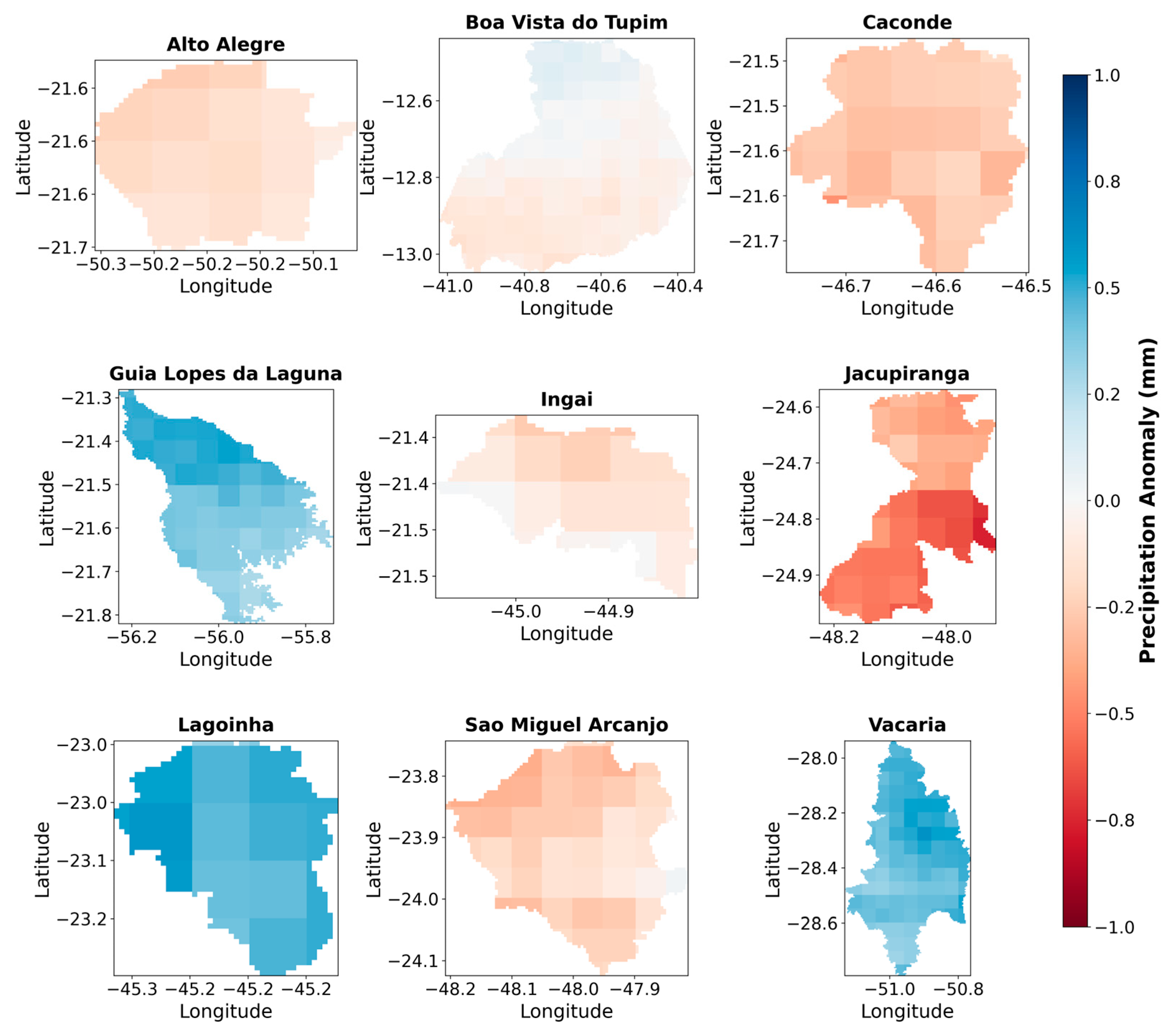
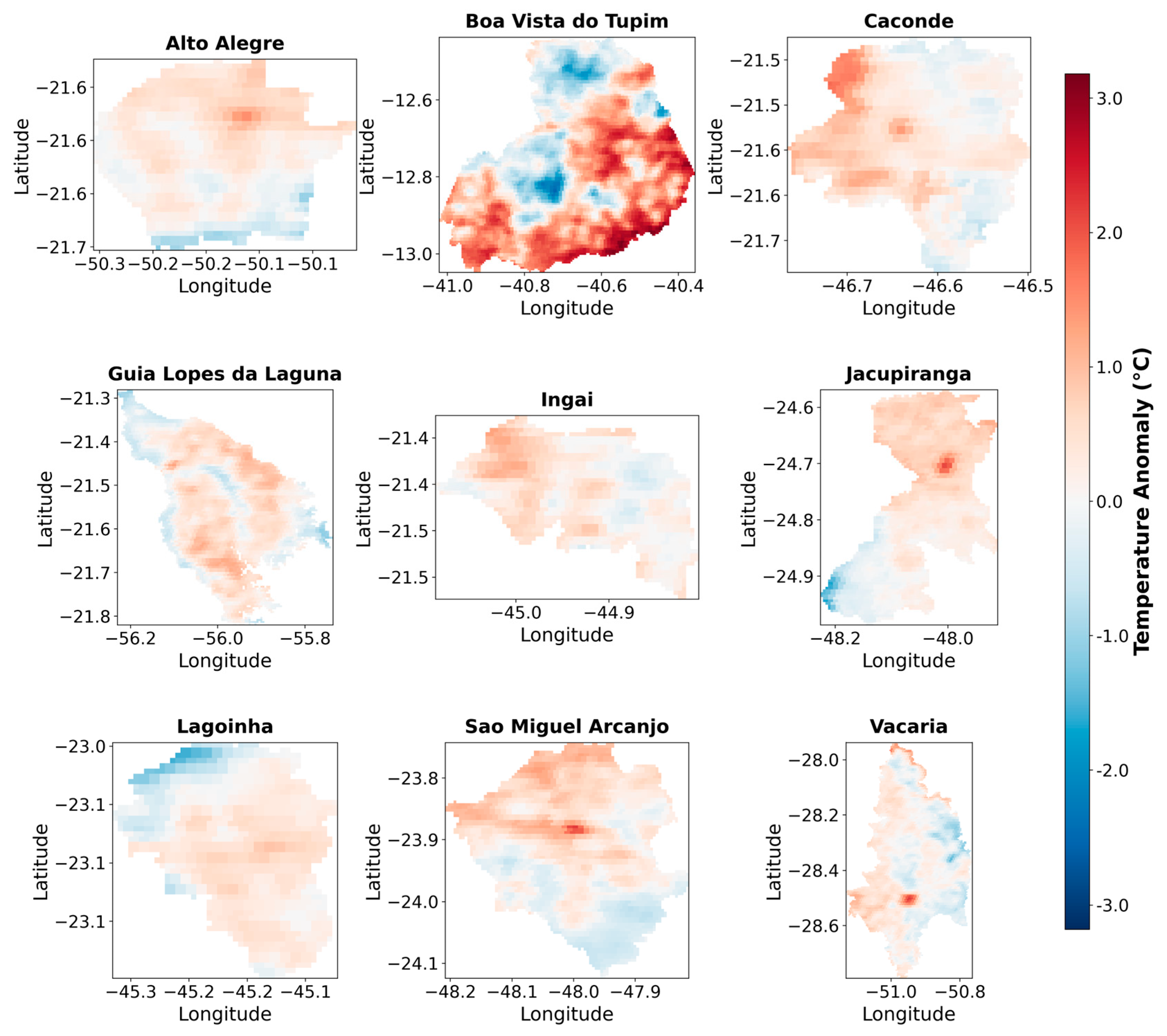

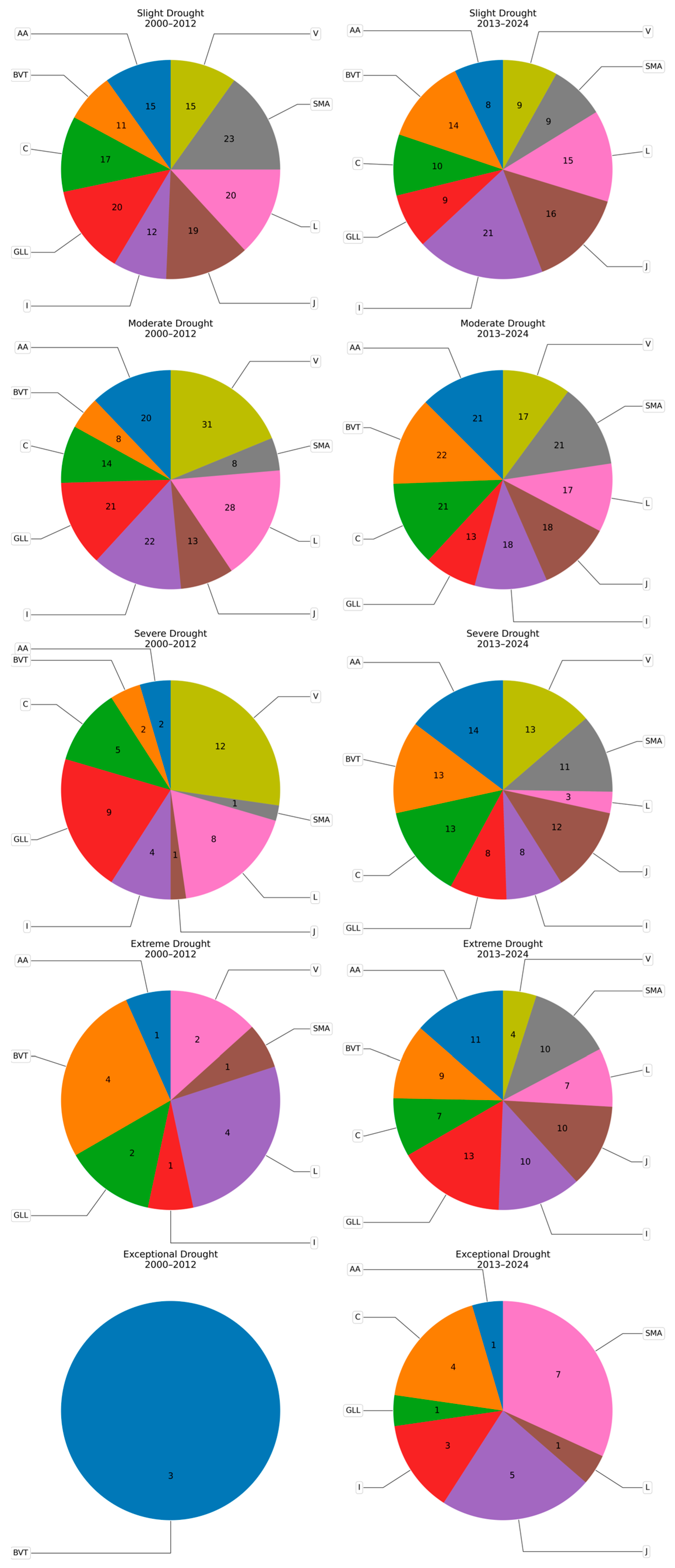
| Agrotechnological Districts | Latitude | Longitude | Elevation (m) |
|---|---|---|---|
| Alto Alegre | −21.58 | −50.16 | 521.0 |
| Boa Vista do Tupim | −12.75 | −41.00 | 260.0 |
| Caconde | −21.50 | −46.75 | 834.0 |
| Guia Lopes da Laguna | −21.50 | −56.00 | 380.0 |
| Ingaí | −21.40 | −44.92 | 951.0 |
| Jacupiranga | −24.75 | −48.00 | 3.0 |
| Lagoinha | −23.00 | −45.25 | 1030.0 |
| São Miguel Arcanjo | −23.85 | −48.16 | 672.0 |
| Vacaria | −28.50 | −51.00 | 1040.0 |
| DATs | State | Lat. | Long. | Mean Elevation (m) | Köppen Climate Classification |
|---|---|---|---|---|---|
| Alto Alegre | São Paulo | −21.58 | −50.16 | 434.67 | Aw Tropical with dry winters |
| Boa Vista do Tupim | Bahia | −12.66 | −40.60 | 436.68 | BSh Dry Semi-arid low latitudes and altitudes |
| Caconde | São Paulo | −21.53 | −46.64 | 868.51 | Cwb Humid subtropical with dry winters and temperate summers |
| Guia Lopes da Laguna | Mato Grosso do Sul | −21.45 | −56.10 | 285.32 | Af Tropical climate without a dry season |
| Ingaí | Minas Gerais | −21.40 | −44.92 | 953.64 | Cwb Humid subtropical with dry winters and temperate summers |
| Jacupiranga | São Paulo | −24.69 | −48.00 | 103.56 | Cfa Humid subtropical oceanic climate lacking a dry season and hot summers |
| Lagoinha | São Paulo | −23.08 | −45.19 | 922.23 | Cwb Humid subtropical with dry winters and temperate summers |
| São Miguel Arcanjo | São Paulo | −23.87 | −47.99 | 700.89 | Cfa Humid subtropical oceanic climate lacking a dry season and hot summers |
| Vacaria | Rio Grande do Sul | −28.50 | −50.93 | 881.40 | Cfb Humid subtropical oceanic climate without a dry season but with temperate summers |
| Metric | Best Value | Analysis Interpretation |
|---|---|---|
| r | 1 or −1 | Direction and strength of a linear relationship |
| MBE | 0 | Performance considering average bias; negative value represents underestimation, and positive value indicates overestimation |
| RMSE | 0 | Measures the average magnitude of errors and is sensitive to large deviations. |
| r | Interpretation |
|---|---|
| 0.00–0.10 | Negligible correlation |
| 0.10–0.39 | Weak correlation |
| 0.40–0.69 | Moderate correlation |
| 0.70–0.89 | Strong correlation |
| 0.90–1.00 | Very strong correlation |
| Category | SPEI | Probably Impacts |
|---|---|---|
| Slight drought | −0.50 to −0.79 | Reduced planting, decreased growth in crops and pastures |
| Moderate drought | −0.80 to −1.29 | Some damage to crops and pastures; streams, reservoirs, or wells at low levels; developing or imminent water shortages; voluntary water use restrictions requested. |
| Severe drought | −1.30 to −1.59 | Likely crop or pasture losses; common water shortages; mandatory water restrictions imposed. |
| Extreme drought | −1.60 to −1.99 | Major losses in crops and pastures; widespread water shortages; strict water restrictions enforced. |
| Exceptional drought | <−2.00 | Exceptional and widespread crops and pasture losses; severe water shortages in reservoirs, streams, and wells create emergencies. |
| Agrotechnological Districts | Mean | Minimum | Maximum | Standard Deviation | MMK Trend | MMK p-Value |
|---|---|---|---|---|---|---|
| Alto Alegre | −0.17 | −0.24 | −0.11 | 0.03 | decreasing | 0.000 |
| Boa Vista do Tupim | −0.04 | −0.36 | 0.20 | 0.11 | no trend | 0.147 |
| Caconde | −0.27 | −0.43 | −0.06 | 0.08 | no trend | 0.729 |
| Guia Lopes da Laguna | 0.42 | 0.24 | 0.57 | 0.05 | increasing | 0.000 |
| Ingaí | −0.12 | −0.20 | 0.00 | 0.04 | no trend | 0.185 |
| Jacupiranga | −0.48 | −1.09 | 0.34 | 0.30 | increasing | 0.000 |
| Lagoinha | 0.49 | 0.08 | 1.13 | 0.22 | no trend | 0.427 |
| São Miguel Arcanjo | −0.22 | −0.52 | 0.15 | 0.12 | increasing | 0.000 |
| Vacaria | 0.45 | 0.35 | 0.55 | 0.04 | increasing | 0.000 |
| Agrotechnological Districts | Mean | Minimum | Maximum | Standard Deviation | MMK Trend | MMK p-Value |
|---|---|---|---|---|---|---|
| Alto Alegre | 0.21 | −1.17 | 1.47 | 0.39 | decreasing | 0.000 |
| Boa Vista do Tupim | 0.70 | −2.52 | 3.18 | 1.13 | increasing | 0.000 |
| Caconde | 0.33 | −0.70 | 1.80 | 0.45 | no trend | 0.687 |
| Guia Lopes da Laguna | 0.26 | −1.13 | 1.30 | 0.44 | no trend | 0.063 |
| Ingaí | 0.28 | −0.56 | 1.27 | 0.36 | decreasing | 0.006 |
| Jacupiranga | 0.32 | −1.68 | 2.11 | 0.46 | decreasing | 0.000 |
| Lagoinha | 0.14 | −1.59 | 0.90 | 0.43 | increasing | 0.032 |
| São Miguel Arcanjo | 0.27 | −0.74 | 2.23 | 0.50 | decreasing | 0.000 |
| Vacaria | 0.09 | −1.42 | 2.25 | 0.41 | no trend | 0.742 |
| Agrotechnological Districts | Month and Year | Worst SPEI-6 | Drought Category |
|---|---|---|---|
| 2000–2012 | |||
| Alto Alegre | July 2005 | −1.69 | Extreme drought |
| Boa Vista do Tupim | September 2012 | −2.60 | Exceptional drought |
| Caconde | July 2010 | −1.57 | Severe drought |
| Guia Lopes da Laguna | July 2005 | −1.73 | Extreme drought |
| Ingaí | July 2007 | −1.62 | Extreme drought |
| Jacupiranga | August 2000 | −1.59 | Extreme drought |
| Lagoinha | December 2003 | −1.94 | Extreme drought |
| São Miguel Arcanjo | August 2000 | −1.88 | Extreme drought |
| Vacaria | October 2006 | −1.73 | Extreme drought |
| 2013–2024 | |||
| Alto Alegre | November 2020 | −2.09 | Exceptional drought |
| Boa Vista do Tupim | March 2017 | −1.87 | Extreme drought |
| Caconde | December 2020 | −2.75 | Exceptional drought |
| Guia Lopes da Laguna | March 2024 | −2.19 | Exceptional drought |
| Ingaí | September 2024 | −2.22 | Exceptional drought |
| Jacupiranga | January 2020 | −2.11 | Exceptional drought |
| Lagoinha | September 2024 | −2.13 | Exceptional drought |
| São Miguel Arcanjo | June 2024 | −2.29 | Exceptional drought |
| Vacaria | December 2021 | −1.91 | Extreme drought |
Disclaimer/Publisher’s Note: The statements, opinions and data contained in all publications are solely those of the individual author(s) and contributor(s) and not of MDPI and/or the editor(s). MDPI and/or the editor(s) disclaim responsibility for any injury to people or property resulting from any ideas, methods, instructions or products referred to in the content. |
© 2025 by the authors. Licensee MDPI, Basel, Switzerland. This article is an open access article distributed under the terms and conditions of the Creative Commons Attribution (CC BY) license (https://creativecommons.org/licenses/by/4.0/).
Share and Cite
da Silva, T.L.; Romani, L.A.S.; Evangelista, S.R.M.; Datcu, M.; Massruhá, S.M.F.S. Drought Monitoring in the Agrotechnological Districts of the Semear Digital Center. Atmosphere 2025, 16, 465. https://doi.org/10.3390/atmos16040465
da Silva TL, Romani LAS, Evangelista SRM, Datcu M, Massruhá SMFS. Drought Monitoring in the Agrotechnological Districts of the Semear Digital Center. Atmosphere. 2025; 16(4):465. https://doi.org/10.3390/atmos16040465
Chicago/Turabian Styleda Silva, Tamires Lima, Luciana Alvim Santos Romani, Silvio Roberto Medeiros Evangelista, Mihai Datcu, and Silvia Maria Fonseca Silveira Massruhá. 2025. "Drought Monitoring in the Agrotechnological Districts of the Semear Digital Center" Atmosphere 16, no. 4: 465. https://doi.org/10.3390/atmos16040465
APA Styleda Silva, T. L., Romani, L. A. S., Evangelista, S. R. M., Datcu, M., & Massruhá, S. M. F. S. (2025). Drought Monitoring in the Agrotechnological Districts of the Semear Digital Center. Atmosphere, 16(4), 465. https://doi.org/10.3390/atmos16040465








